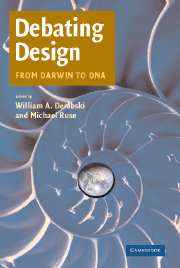Book contents
- Frontmatter
- Contents
- Notes on Contributors
- Debating Design
- INTRODUCTION
- PART I DARWINISM
- PART II COMPLEX SELF-ORGANIZATION
- 8 Prolegomenon to a General Biology
- 9 Darwinism, Design, and Complex Systems Dynamics
- 10 Emergent Complexity, Teleology, and the Arrow of Time
- 11 The Emergence of Biological Value
- PART III THEISTIC EVOLUTION
- PART IV INTELLIGENT DESIGN
- Index
- References
11 - The Emergence of Biological Value
Published online by Cambridge University Press: 05 June 2012
- Frontmatter
- Contents
- Notes on Contributors
- Debating Design
- INTRODUCTION
- PART I DARWINISM
- PART II COMPLEX SELF-ORGANIZATION
- 8 Prolegomenon to a General Biology
- 9 Darwinism, Design, and Complex Systems Dynamics
- 10 Emergent Complexity, Teleology, and the Arrow of Time
- 11 The Emergence of Biological Value
- PART III THEISTIC EVOLUTION
- PART IV INTELLIGENT DESIGN
- Index
- References
Summary
INTRODUCTION
All the things we think of as paradigmatic cases of design – novels, paintings, symphonies, clothes, houses, automobiles, computers – are the work of human hands guided by human minds. Thus, design might be defined as matter arranged by a mind for a purpose that it values. But this raises the question, what are minds? Presumably, the activity of brains. The problem with this answer, however, is that brains themselves give every appearance of being designed. Most contemporary thinkers view brains as neurons arranged for the purpose of thinking in much the same way that, say, mousetraps are springs and levers arranged for the purpose of killing mice. But if that is so, then who arranged the neurons? Who or what values thinking, and whose purpose does it serve?
It is generally supposed that there are only two ways to answer these questions. One way has come to be known as Intelligent Design. On this view, our brains were designed by other minds existing elsewhere – say, in another galaxy or on another plane of being. But if these other minds are also instantiated in matter, then we have the same problem all over again. If not, then we have an even more difficult problem than the one we started with. To invoke immaterial minds to explain the design of material ones is surely a case of obscurum per obscurius.
- Type
- Chapter
- Information
- Debating DesignFrom Darwin to DNA, pp. 210 - 226Publisher: Cambridge University PressPrint publication year: 2004
References
- 1
- Cited by



